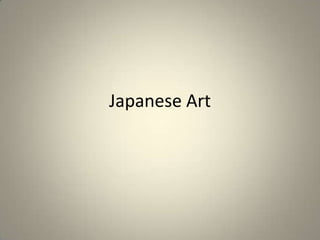
Japanese art
- 1. Japanese Art
- 2. Students will be able to… • Explain the forms of Buddhism practiced in Japan and their effect on the country’s culture • Examine Japan’s literary and dramatic developments • Describe themes associated with Japanese art forms
- 3. Zen Buddhism • Prince Shotoku encouraged the spread of Buddhism in Japan • Buddhism was practiced alongside Shinto • The Buddhist belief that peace and happiness could be gained by leading a life of virtue and wisdom appealed to many.
- 4. Japanese Forms of Buddhism • Different forms of Buddhism developed in Japan – Tendai Buddhism focused on the intensive study of texts – Shigon had complex rituals – Amida, Pure land, believed that people might have salvation in a pure land after their death – Zen believed that something precious and divine exists in each person
- 5. Zen Buddhism • Beginning in the 1100’s Zen Buddhism became common • Zen Buddhism emphasizes on self-discipline, simplicity, and meditation • “Zen” = meditation • Followers believe that quiet reflection was more useful than performing ceremonies or studying scriptures • Focus on individuals attempt to achieve inner peace
- 6. Zen Buddhism • Samurai favored Zen Buddhism because they thought it would give them inner peace and strength in battle • Samurai reflected the strength they felt they achieved in meditation by drawing in black ink and using thick, strong, black lines
- 7. Literature and Drama • A great period of literature began beginning in the 800’s • Around 400 The Japanese begun using Chinese characters to write Japanese words – The Japanese use characters to stand for specific objects, actions, ideas, or sounds
- 8. Japanese Drama • Drama began to gain popularity in the 600’s • In the 1300’s Noh theater began – Retelling of legends and folktales – Actors wore painted wooden masks to show emotions – Gestures, costumes, and music were used to help tell the story – Most actors were men and the plays were often performed for both upper and lower classes
- 9. Japanese Drama • In the early 1600’s Kabuki developed • Combined melodramatic singing and dancing with elaborate costumes • Actors wore heavy make up • More informal than Noh • Themes dealt with common people • Only performed by men
- 10. Tale of the Genji • In the early 800’s Japan ended diplomatic relations with China • Literature reflected emerging Japanese culture independent from China • One of Japan’s finest writers was Lady Murasaki Shikibu. She lived at the emperors court in the early 1000’s • She wrote a book called The Tale of the Genji about life in the imperial court – important because it focused on realistic events focused on one individual. The world’s first important novel
- 11. Japanese Poetry: Haiku • Short form of poetry 5, 7, 5 • Usually about love, romance, or nature • Matsuo Basho a famous poet from the 1600’s – He wrote poems that had a quiet reflective spirit of Zen An old silent pond Into the pond a frog jumps Splash! Silence again
- 12. Distinctive Japanese Arts Calligraphy and Painting • Japanese consider writing as a way to express beauty • Each character is painted in a set order of brush strokes • Brush painting with ink on paper scrolls and silk began in the 600’s – Depict landscapes, historical events, and daily life – Sometimes a short description was on the painting itself
- 13. Distinctive Japanese Art Flower Arranging and Gardening • Ikebana- The art of flower arranging was brought to Japan by Buddhists – Emphasis on simplicity • Bonsai – art of growing miniature trees and shrubs in small pots or trays • Zen gardens are designed to help people think quietly – Arranged with rocks and pathways and few flowers or trees